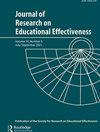失望的秘诀:政策、效应大小和赢家的诅咒
IF 1.6
4区 教育学
Q2 EDUCATION & EDUCATIONAL RESEARCH
Journal of Research on Educational Effectiveness
Pub Date : 2022-06-07
DOI:10.1080/19345747.2022.2066588
引用次数: 5
摘要
标准化效应量估计通常被“循证教育界”用作判断一系列研究中干预措施的相对重要性、有效性或实际意义的关键指标:效应量越大,表明干预措施越有效。然而,这种说法很少适用;只有在每个研究中使用线性相等的结果,相同的比较处理和具有同等代表性的样本时。本文章由计算机程序翻译,如有差异,请以英文原文为准。
A Recipe for Disappointment: Policy, Effect Size, and the Winner’s Curse
Standardized effect size estimates are commonly used by the ‘evidence-based education’ community as a key metric for judging relative importance, effectiveness, or practical significance of interventions across a set of studies: larger effect sizes indicate more effective interventions. However, this argument applies rarely; only when linearly equatable outcomes, identical comparison treatments and equally representative samples are used in every study.
求助全文
通过发布文献求助,成功后即可免费获取论文全文。
去求助
来源期刊

Journal of Research on Educational Effectiveness
EDUCATION & EDUCATIONAL RESEARCH-
CiteScore
4.00
自引率
11.10%
发文量
37
期刊介绍:
As the flagship publication for the Society for Research on Educational Effectiveness, the Journal of Research on Educational Effectiveness (JREE) publishes original articles from the multidisciplinary community of researchers who are committed to applying principles of scientific inquiry to the study of educational problems. Articles published in JREE should advance our knowledge of factors important for educational success and/or improve our ability to conduct further disciplined studies of pressing educational problems. JREE welcomes manuscripts that fit into one of the following categories: (1) intervention, evaluation, and policy studies; (2) theory, contexts, and mechanisms; and (3) methodological studies. The first category includes studies that focus on process and implementation and seek to demonstrate causal claims in educational research. The second category includes meta-analyses and syntheses, descriptive studies that illuminate educational conditions and contexts, and studies that rigorously investigate education processes and mechanism. The third category includes studies that advance our understanding of theoretical and technical features of measurement and research design and describe advances in data analysis and data modeling. To establish a stronger connection between scientific evidence and educational practice, studies submitted to JREE should focus on pressing problems found in classrooms and schools. Studies that help advance our understanding and demonstrate effectiveness related to challenges in reading, mathematics education, and science education are especially welcome as are studies related to cognitive functions, social processes, organizational factors, and cultural features that mediate and/or moderate critical educational outcomes. On occasion, invited responses to JREE articles and rejoinders to those responses will be included in an issue.
 求助内容:
求助内容: 应助结果提醒方式:
应助结果提醒方式:


